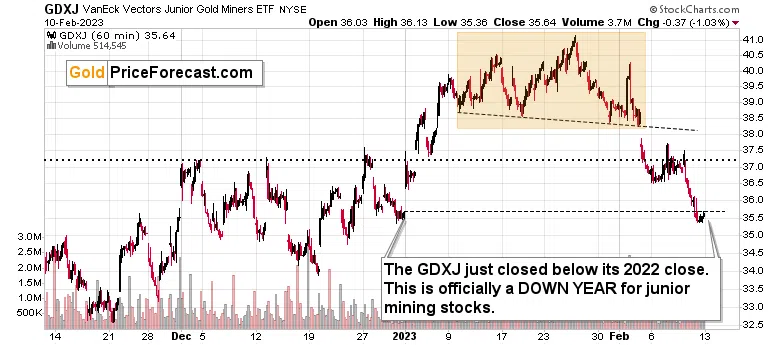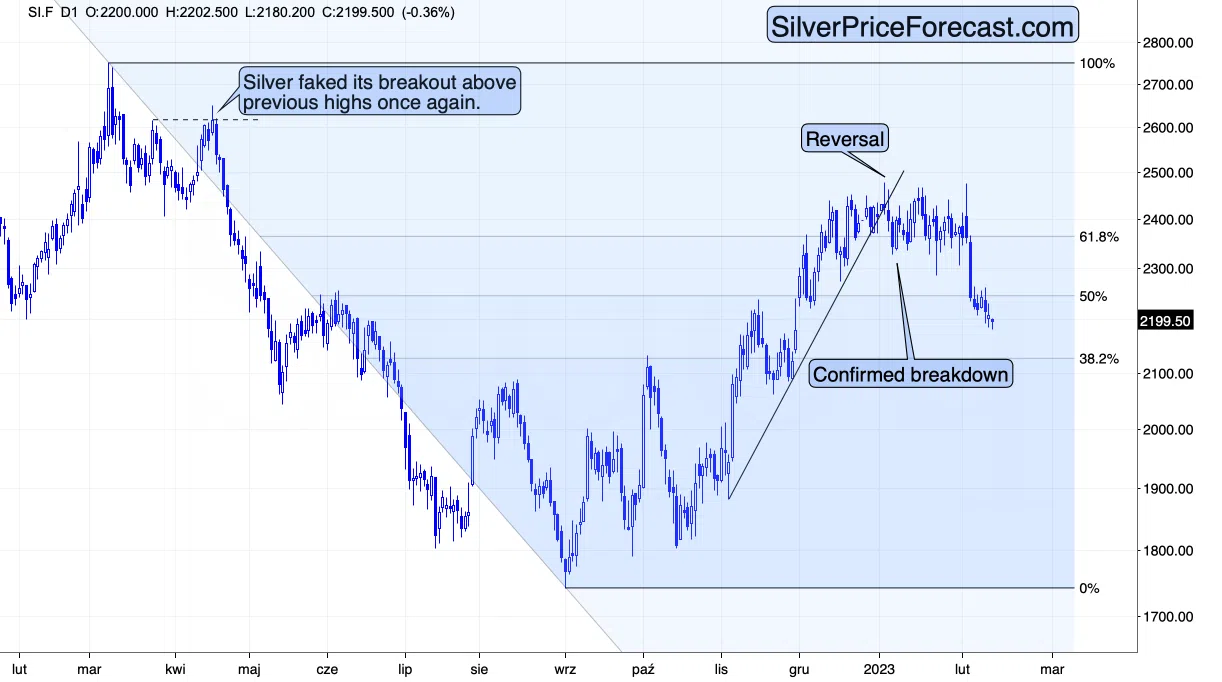The Powerful 2023 Reversal in Gold Stocks
It’s official – 2023 is a down year for the GDXJ – the key proxy for junior mining stocks, and since mining stocks tend to lead gold…
The GDXJ’s closing price on Dec. 31, 2022, had been $35.65. And on Friday, it closed at $35.64. Some might say that it’s just one cent, but it’s a very meaningful cent in this case because the yearly closing price and the weekly closing price are both important.

This means that the entire performance of the GDXJ ETF so far this year has been one huge reversal. A rally that gold permabulls welcomed so much turned out to be something fake, just as I had warned. And since the GDXJ has been making lower lows and lower highs since its 2020 top, it’s really hard to ignore the fact that it’s been in a medium-term downtrend for quite a long time.
No breakout; no yearly rally.
It’s difficult to spot anything bullish in that picture. Sure, some people will always find a way to find something bullish in any situation – for example, gold’s recent short-term rally was quite significant. While focusing on the very near term, it’s easy to forget that gold actually failed to move above its 2011 highs (from well over a decade ago!) in nominal terms (in real terms, gold is much lower), despite so many dollars and other currencies being printed in the meantime, and despite the pandemic. And, you know… In case you forgot – there’s war in Europe!
Why isn’t the gold price above $5,000 given all those circumstances? Or at least above $3,000? Why didn't silver recover at least half of the declines from its 2011 high in nominal terms (it was much lower in real terms)? And junior mining stocks? The GDXJ is now trading for just a little more than a quarter of its value at the 2011 high. In nominal terms.
There are two primary fundamental drivers of gold prices: real interest rates and the USD Index.
The real rates are going up as the nominal rates are going higher (faster or slower, but they are still rising) and the inflation rate is declining (and so are expectations regarding it). If rates were about to overshoot inflation (as has historically been the case if the Fed wanted to fight inflation), this would imply an additional 2% increase in real interest rates.. This means a powerful bearish force is about to hit the gold market. In fact, it’s already here to a large extent, and it seems that investors are no longer able to ignore it due to gold’s yet another failure to move above its 2011 high.
And the USD Index? It corrected half of its decline after a truly extraordinary rally. Last week, the USD Index closed back above both the 2016 and 2020 highs. The attempt to break below these highs was invalidated. This is extremely bullish for the following weeks as far as the U.S. dollar is concerned. And since it tends to move in the opposite direction to gold, silver, and mining stocks, the latter are likely to get a very bearish push.
Yes, the PMs declined profoundly last week, but it seems to be just a blip on the radar screen compared to what’s coming. Just look at how tiny the rally in the USD Index is so far.

The USDX moved higher by just a few index points from its recent low, but it already did two very important technical things.
- It confirmed the breakout above the declining red resistance line, which just became support. This is a classic, unsophisticated buy signal that the entire world saw.
- It invalidated the small move below the 50% Fibonacci retracement and the mid-2022 low. This invalidation is strongly bullish.
The above means that the USDX is ready to soar once again. During its previous upswing, gold declined by over $400. This time, gold’s decline starts from higher levels, so it could (and in my view, it’s likely to) fall below its 2022 lows.
The lower part of the above chart shows the correlation between gold and the USD Index. It’s been very low (and that’s the case most of the time), which means that they are indeed likely to move in opposite directions.
On a short-term note, the silver price just moved to new 2023 lows.

In fact, it’s trading below its November high. Is this how a strong market performs?
No.
Oh, and let’s keep in mind that silver is widely used in many industries due to its unique properties. It’s the top conductor of electricity and heat – more expensive than copper, but sometimes the best conductor has to be used, so silver has no substitutes in that regard – there’s no other “best conductor.”
The above means that silver should be, and in practice is, linked to the performance of the general stock market. This makes silver’s recent performance even worse!
Stocks moved higher in 2023, but silver failed to move above $25. In fact, it resisted confirming breakouts above the $24 level and its 61.8% Fibonacci retracement.
Silver is in freefall despite the stock’s strength so far this year, which means that it’s been extremely weak.
When gold falls and stocks fall (which is also likely, e.g., based on a higher USD, which implies less competitive exports, and based on higher interest rates), silver is likely to fall particularly hard. Truth be told, the biggest declines (and, in my opinion, the biggest profit potential as long as one is positioned to gain from them) are to be seen in the junior mining stocks.
Thank you for reading our free analysis today. Please note that the above is just a small fraction of the full analyses that our subscribers enjoy on a regular basis. They include multiple premium details such as the interim targets for gold and mining stocks that could be reached in the next few weeks. We invite you to subscribe now and read today’s issue right away.
Sincerely,
Przemyslaw K. Radomski, CFA
Founder, Editor-in-chief